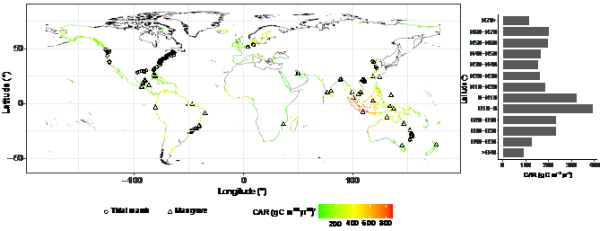

Coastal wetlands are important ecosystems, especially in mitigating climate change. Prof. Faming Wang from South China Botanical Garden, Chinese Academy of Sciences, and Prof. Sanders from Southern Cross University, Australia worked together with several colleagues around the globe to examine coastal blue carbon burial rates. They showed that climate change will increase the carbon sequestration capacity of these systems around the world during this century.
In a recent publication in National Science Review, Prof. WANG and Prof. Sanders lead an international group to go beyond recent soil C stock estimates, to reveal global tidal wetland C accumulation and predict changes under relative sea level rise, temperature and precipitation. They found that global tidal wetlands accumulate ~54 Tg C yr-1, which is ~30% of the organic C buried on the ocean floor (Figure 1). Modelling based on current climatic drivers and under projected emissions scenarios revealed an increase of up to ~300 g C m-2 yr-1 by 2100 as an average global C accumulation rate (Figure 2). This rapid increase was found here to be driven by sea-level rise in tidal marshes, and higher temperature and precipitation in mangroves. Their results highlight the feedbacks between climate change and C sequestration in tidal wetlands (Figure 2). The results from this study demonstrate that preserving and rehabilitating mangroves and salt marshes will remain an effective approach in tackling global climate change with significant regional benefits in tidal wetland-rich countries.
This work was funded by National Natural Science Foundation of China, the Guangdong Natural Science Foundation for Distinguished Young Scholars, Australian Research Council and NOAA National Estuarine Research Reserve Science Collaborative.
For further reading,please refer to: https://doi.org/10.1093/nsr/nwaa296.

Figure 1. The spatial distribution of tidal wetlands and the observed C accumulation rate (CAR) points. The right panel indicated the arithmetic average CAR at every 10-degree bands of latitude.

Figure 2. Projected global change in tidal wetland C sequestration. Results are displayed for moderate-emission scenario (RCP4.5) and high-emission scenario (RCP8.5) under the most restricted human adaptation scenario (i.e. population density threshold set as 5 people km-2; higher population density than this value would have no lateral accommodation space for tidal wetlands), giving the most conservative predicted increases in the global carbon accumulation rates found in this study. The colored shadings represent the 95% range (2.5%-97.5%) of the projected C distribution in global tidal wetlands. The solid lines denote the median of the distribution.

